Using Human Movement Data to Identify Potential Areas of Zika Transmission: Case Study of the Largest Zika Cluster in Singapore
Abstract
1. Introduction
2. Materials and Methods
2.1. Data Collection
- Whenever there are activities on the phone which engage a service of the Telco, such as usage of mobile data, including applications running in the background, calls or short message services.
- Whenever the phone moves into another location area code.
- Periodically, there is a location update (roughly once every 2 to 3 h) if there is no activity or movement to another location area code.
2.2. Quantifying Human Movement Using Mobile Phone Data
- Construction workers: Subscribers who dwelled in the construction site hexagon within the Aljunied Crescent ZIKV cluster locality at least five times per week for more than 4 h on each occurrence, were at least 18 years old and were from the following countries (Malaysia, People’s Republic of China, India, Sri Lanka, Thailand, Bangladesh, Myanmar, Phillipines, Hongkong, Macau, South Korea and Taiwan) and categorized as construction workers. The countries were chosen as per the Ministry of Manpower’s work permit requirement criteria for construction workers [21].
- Residents: Subscribers who dwelled in the Aljunied Crescent ZIKV cluster locality at least five times per week for more than 4 h on each occurrence and resided in the locality (based on their home addresses) were categorized as residents. There will be no overlap with the category of construction workers, as construction workers do not have residential addresses within the area.
- Visitors: subscribers who dwelled in the Aljunied Crescent ZIKV cluster locality at least five times per week for more than 4 h on each occurrence and did not reside in the locality (based on their home addresses) were categorized as visitors. In this category also, subscribers who overlapped with the category of construction workers were excluded from this group.
2.3. Statistical Analyses
- “a”
- denotes the number of hexagons reported with at least one ZIKV case and at least one person moving into a hexagon.
- “b”
- denotes the number of hexagons with no ZIKV case and at least one person moving into a hexagon.
- “c”
- denotes the number of hexagons with at least one ZIKV case and nobody moving into a hexagon.
- “d”
- denotes the number of hexagons with no ZIKV case and nobody moving into a hexagon.
3. Results
4. Discussion
5. Conclusions
Author Contributions
Funding
Acknowledgments
Conflicts of Interest
References
- Dick, G.W.; Kitchen, S.F.; Haddow, A.J. Zika virus (I). Isolations and serological specificity. Trans. R. Soc. Trop. Med. Hyg. 1952, 46, 509–520. [Google Scholar] [CrossRef]
- Duffy, M.R.; Chen, T.H.; Hancock, W.T.; Powers, A.M.; Kool, J.L.; Lanciotti, R.S.; Pretrick, M.; Marfel, M.; Holzbauer, S.; Dubray, C.; et al. Zika virus outbreak on Yap Island, federated states of Micronesia. N. Engl. J. Med. 2009, 360, 2536–2543. [Google Scholar] [CrossRef] [PubMed]
- Cao-Lormeau, V.M.; Roche, C.; Teissier, A.; Robin, E.; Berry, A.L.; Mallet, H.P.; Sall, A.A.; Musso, D. Zika virus, French polynesia, South pacific, 2013. Emerg. Infect. Dis. 2014, 20, 1085. [Google Scholar] [CrossRef] [PubMed]
- Chen, L.H.; Hamer, D.H. Zika virus: Rapid spread in the western hemisphere. Ann. Intern. Med. 2016, 164, 613–615. [Google Scholar] [CrossRef] [PubMed]
- Ho, Z.J.; Hapuarachchi, H.C.; Barkham, T.; Chow, A.; Ng, L.C.; Lee, J.M.; Leo, Y.S.; Prem, K.; Lim, Y.H.; de-Sessions, P.F.; et al. Outbreak of Zika virus infection in Singapore: An epidemiological, entomological, virological, and clinical analysis. Lancet Infect. Dis. 2017, 17, 813–821. [Google Scholar] [CrossRef]
- Hazin, A.N.; Poretti, A.; Di-Cavalcanti-Souza-Cruz, D.; Tenorio, M.; Van-Der-Linden, A.; Pena, L.J.; Brito, C.; Gil, L.H.; de Barros Miranda-Filho, D.; Marques, E.T.; et al. Computed tomographic findings in microcephaly associated with Zika virus. N. Engl. J. Med. 2016, 374, 2193–2195. [Google Scholar] [CrossRef] [PubMed]
- Lee, B.Y.; Alfaro-Murillo, J.A.; Parpia, A.S.; Asti, L.; Wedlock, PT.; Hotez, PJ.; Galvani, A.P. The potential economic burden of Zika in the continental United States. PLoS Negl. Trop. Dis. 2017, 11, e0005531. [Google Scholar] [CrossRef] [PubMed]
- Wiwanitkit, V. The current status of Zika virus in Southeast Asia. Epidemiol. Health 2016, 38, e2016026. [Google Scholar] [CrossRef] [PubMed]
- Ferguson, N.M.; Cummings, D.A.; Cauchemez, S.; Fraser, C.; Riley, S.; Meeyai, A.; Iamsirithaworn, S.; Burke, D.S. Strategies for containing an emerging influenza pandemic in Southeast Asia. Nature 2005, 437, 209. [Google Scholar] [CrossRef] [PubMed]
- Eubank, S.; Guclu, H.; Kumar, V.A.; Marathe, M.V.; Srinivasan, A.; Toroczkai, Z.; Wang, N. Modelling disease outbreaks in realistic urban social networks. Nature 2004, 429, 180. [Google Scholar] [CrossRef] [PubMed]
- Stoddard, ST.; Morrison, AC.; Vazquez-Prokopec, GM.; Soldan, V.P.; Kochel, T.J.; Kitron, U.; Elder, JP.; Scott, T.W. The role of human movement in the transmission of vector-borne pathogens. PLoS Negl. Trop. Dis. 2009, 3, e481. [Google Scholar] [CrossRef] [PubMed]
- Stoddard, S.T.; Forshey, B.M.; Morrison, A.C.; Paz-Soldan, V.A.; Vazquez-Prokopec, G.M.; Astete, H.; Reiner, R.C.; Vilcarromero, S.; Elder, J.P.; Halsey, E.S.; et al. House-to-house human movement drives dengue virus transmission. Proc. Natl. Acad. Sci. USA 2013, 110, 994–999. [Google Scholar] [CrossRef] [PubMed]
- Wesolowski, A.; Buckee, C.O.; Engø-Monsen, K.; Metcalf, C.J. Connecting mobility to infectious diseases: The promise and limits of mobile phone data. J. Infect. Dis. 2016, 214 (Suppl. 4), S414–S420. [Google Scholar] [CrossRef] [PubMed]
- Bengtsson, L.; Gaudart, J.; Lu, X.; Moore, S.; Wetter, E.; Sallah, K.; Rebaudet, S.; Piarroux, R. Using mobile phone data to predict the spatial spread of cholera. Sci. Rep. 2015, 5, 8923. [Google Scholar] [CrossRef] [PubMed]
- Bengtsson, L.; Lu, X.; Thorson, A.; Garfield, R.; Von-Schreeb, J. Improved response to disasters and outbreaks by tracking population movements with mobile phone network data: A post-earthquake geospatial study in Haiti. PLoS Med. 2011, 8, e1001083. [Google Scholar] [CrossRef] [PubMed]
- Wesolowski, A.; Eagle, N.; Tatem, A.J.; Smith, D.L.; Noor, A.M.; Snow, R.W.; Buckee, C.O. Quantifying the impact of human mobility on malaria. Science 2012, 338, 267–270. [Google Scholar] [CrossRef] [PubMed]
- Wesolowski, A.; Qureshi, T.; Boni, M.F.; Sundsøy, P.R.; Johansson, M.A.; Rasheed, S.B.; Engø-Monsen, K.; Buckee, C.O. Impact of human mobility on the emergence of dengue epidemics in Pakistan. Proc. Natl. Acad. Sci. USA 2015, 112, 11887–11892. [Google Scholar] [CrossRef] [PubMed]
- Leo, Y.S.; Chow, A. Zika virus has arrived in Singapore. Lancet Infect. Dis. 2016, 16, 1317–1319. [Google Scholar] [CrossRef]
- Chow, A.; Ho, H.; Win, M.K.; Leo, Y.S. Assessing sensitivity and specificity of surveillance case definitions for Zika virus disease. Emerg. Infect. Dis. 2017, 23, 677. [Google Scholar] [CrossRef] [PubMed]
- Maurer-Stroh, S.; Mak, T.M.; Ng, Y.K.; Phuah, S.P.; Huber, R.G.; Marzinek, J.K.; Holdbrook, D.A.; Lee, R.T.; Cui, L.; Lin, R.T. South-east Asian Zika virus strain linked to cluster of cases in Singapore, August 2016. Eurosurveillance 2016, 21, 30347. [Google Scholar] [CrossRef] [PubMed]
- Construction Sector: Work Permit Requirements. 6 December 2019. Available online: https://www.mom.gov.sg/passes-and-permits/work-permit-for-foreign-worker/sector-specific-rules/construction-sector-requirements (accessed on 27 December 2018).
- DeLong, E.R.; DeLong, D.M.; Clarke-Pearson, D.L. Comparing the areas under two or more correlated receiver operating characteristic curves: A nonparametric approach. Biometrics 1988, 44, 837–845. [Google Scholar] [CrossRef] [PubMed]
- City Population, Singapore Sub Division. 28 September 2018. Available online: https://www.citypopulation.de/php/singapore-admin.php (accessed on 27 December 2018).
- Department of Singapore Statistics. Population and Population Structure. 19 May 2018. Available online: https://www.singstat.gov.sg/find-data/search-by-theme/population/population-and-population-structure/latest-data (accessed on 27 December 2018).
- Martens, P.; Hall, L. Malaria on the move: Human population movement and malaria transmission. Emerg. Infect. Dis. 2000, 6, 103. [Google Scholar] [CrossRef] [PubMed]
- Ruktanonchai, N.W.; DeLeenheer, P.; Tatem, A.J.; Alegana, V.A.; Caughlin, T.T.; zu Erbach-Schoenberg, E.; Lourenço, C.; Ruktanonchai, C.W.; Smith, D.L. Identifying malaria transmission foci for elimination using human mobility data. PLoS Comput. Biol. 2016, 12, e1004846. [Google Scholar] [CrossRef] [PubMed]
- Ong, J.; Liu, X.; Rajarethinam, J.; Kok, S.Y.; Liang, S.; Tang, C.S.; Cook, A.R.; Ng, L.C.; Yap, G. Mapping dengue risk in Singapore using Random Forest. PLoS Negl. Trop. Dis. 2018, 12, e0006587. [Google Scholar] [CrossRef] [PubMed]
- Liang, S.; Hapuarachchi, H.C.; Rajarethinam, J.; Koo, C.; Tang, C.S.; Chong, C.S.; Ng, L.C.; Yap, G. Construction sites as an important driver of dengue transmission: Implications for disease control. BMC Infect. Dis. 2018, 18, 382. [Google Scholar] [CrossRef] [PubMed]
- Ong, J.; Liu, X.; Rajarethinam, J.; Yap, G.; Ho, D.; Ng, L.C. A novel entomological index, Aedes Aegypti Breeding Percentage, reveals the geographical spread of the dengue vector in Singapore and serves as a spatial risk indicator for dengue. Parasit. Vectors 2019, in press. [Google Scholar] [CrossRef] [PubMed]
- Hapuarachchi, H.C.; Koo, C.; Rajarethinam, J.; Chong, C.S.; Lin, C.; Yap, G.; Liu, L.; Lai, Y.L.; Ooi, P.L.; Cutter, J.; et al. Epidemic resurgence of dengue fever in Singapore in 2013–2014: A virological and entomological perspective. BMC Infect. Dis. 2016, 16, 300. [Google Scholar] [CrossRef] [PubMed]
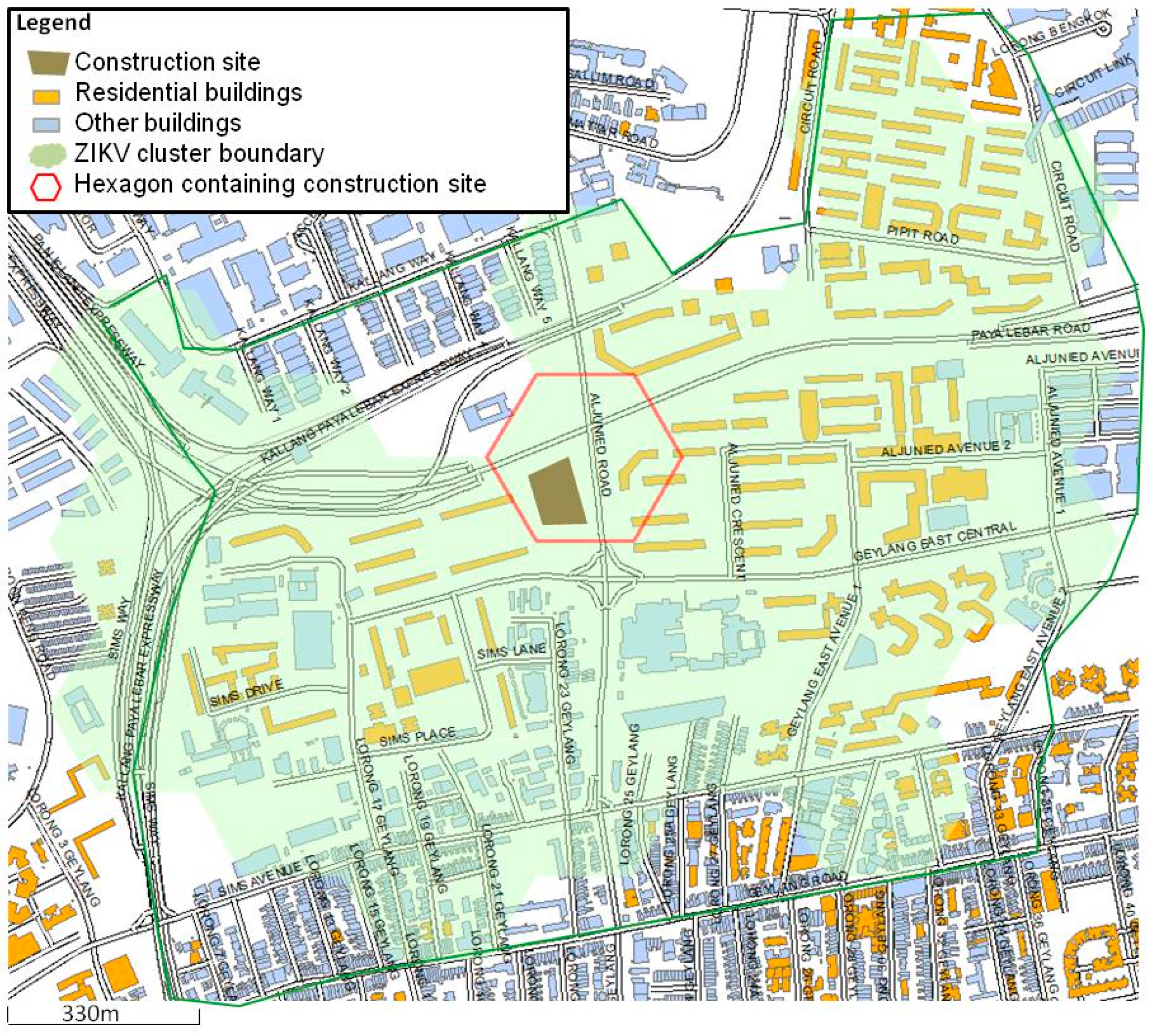
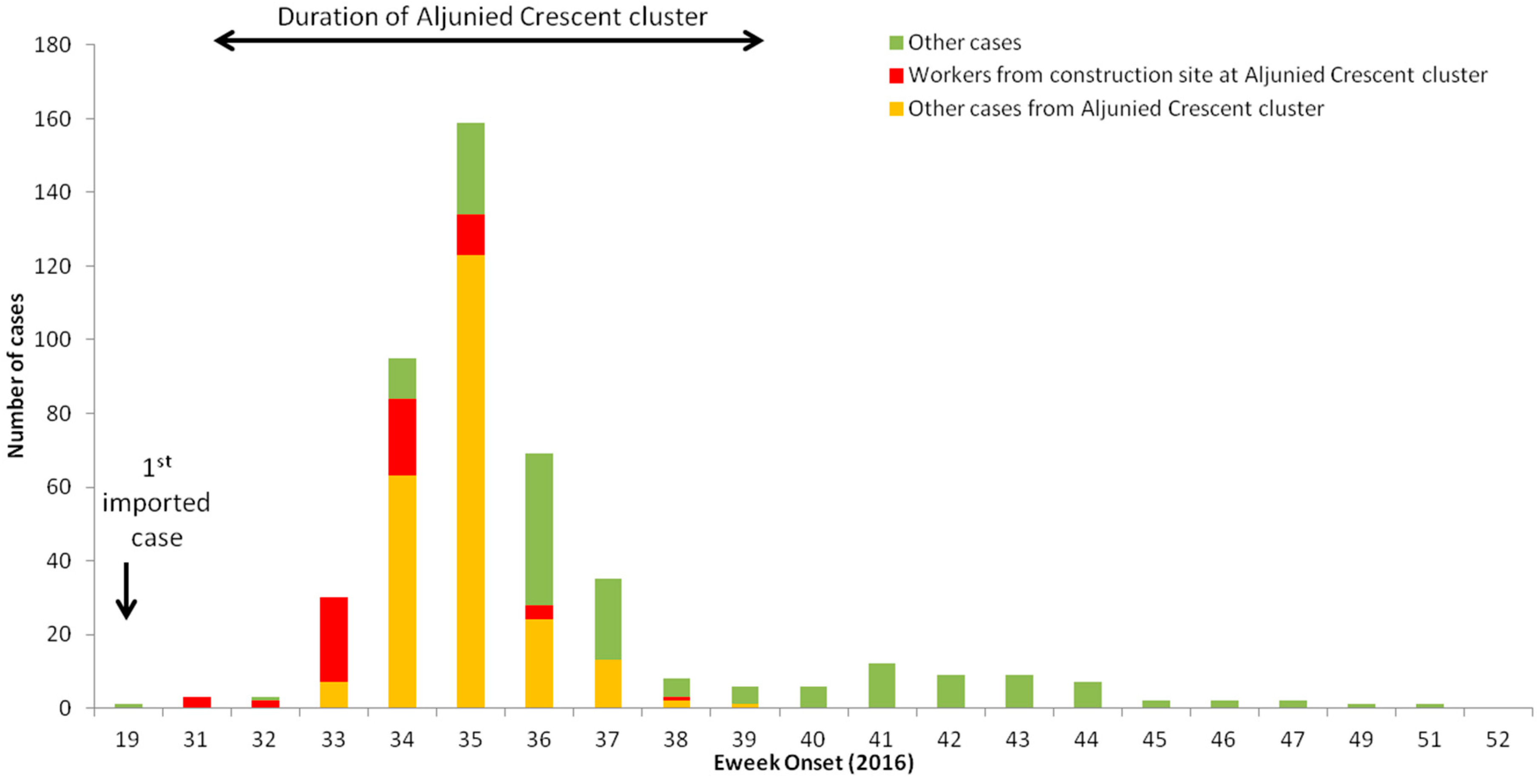

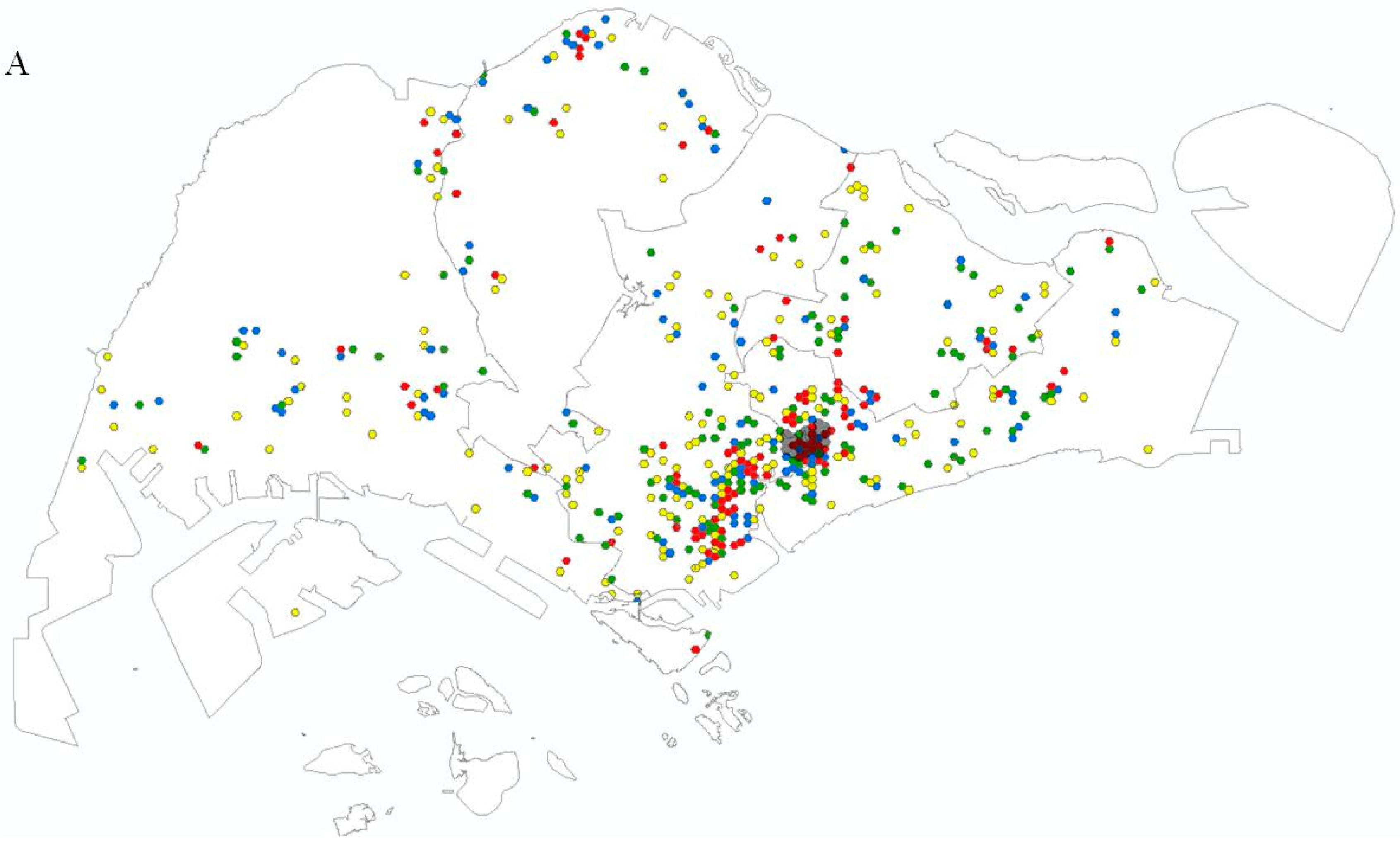
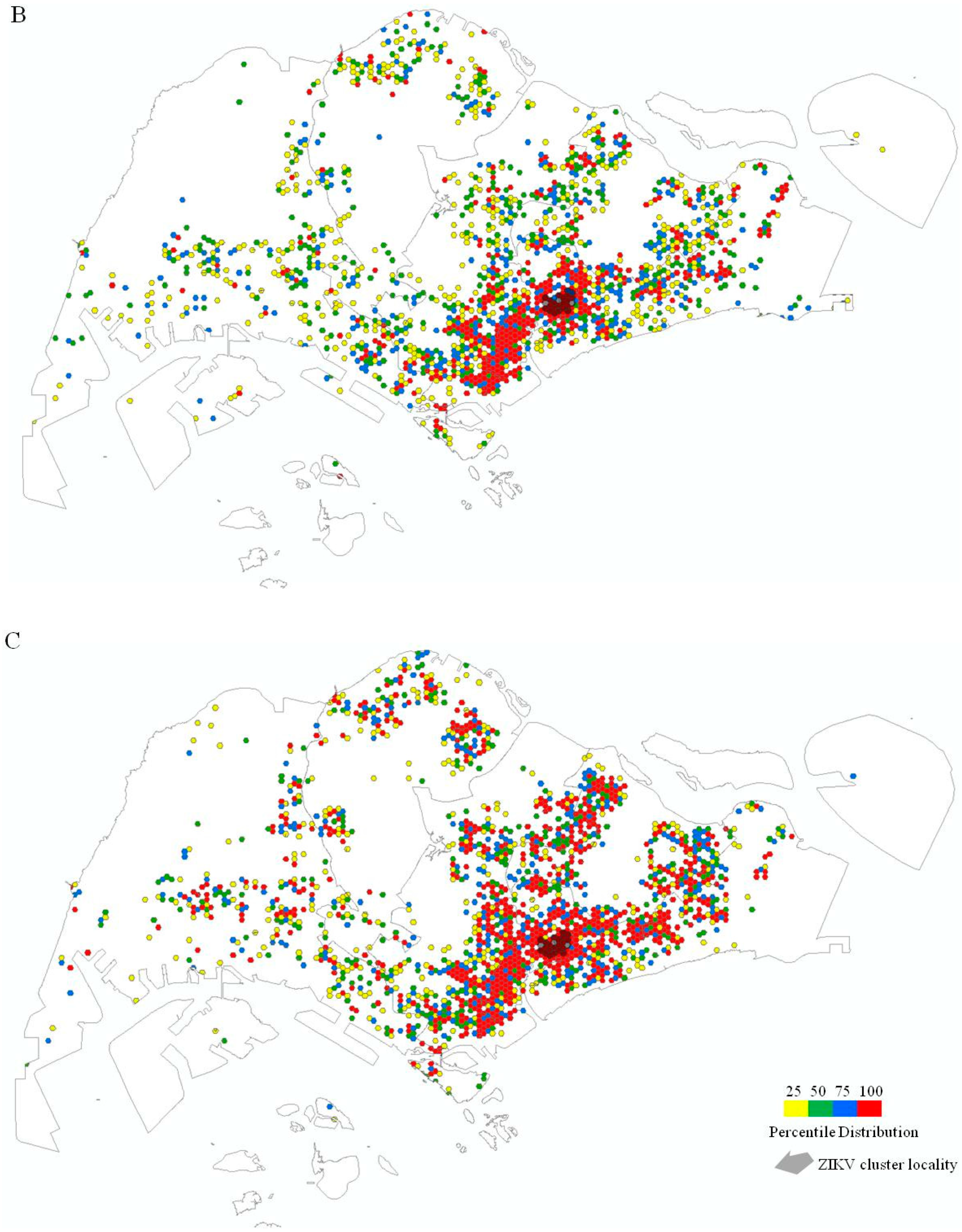
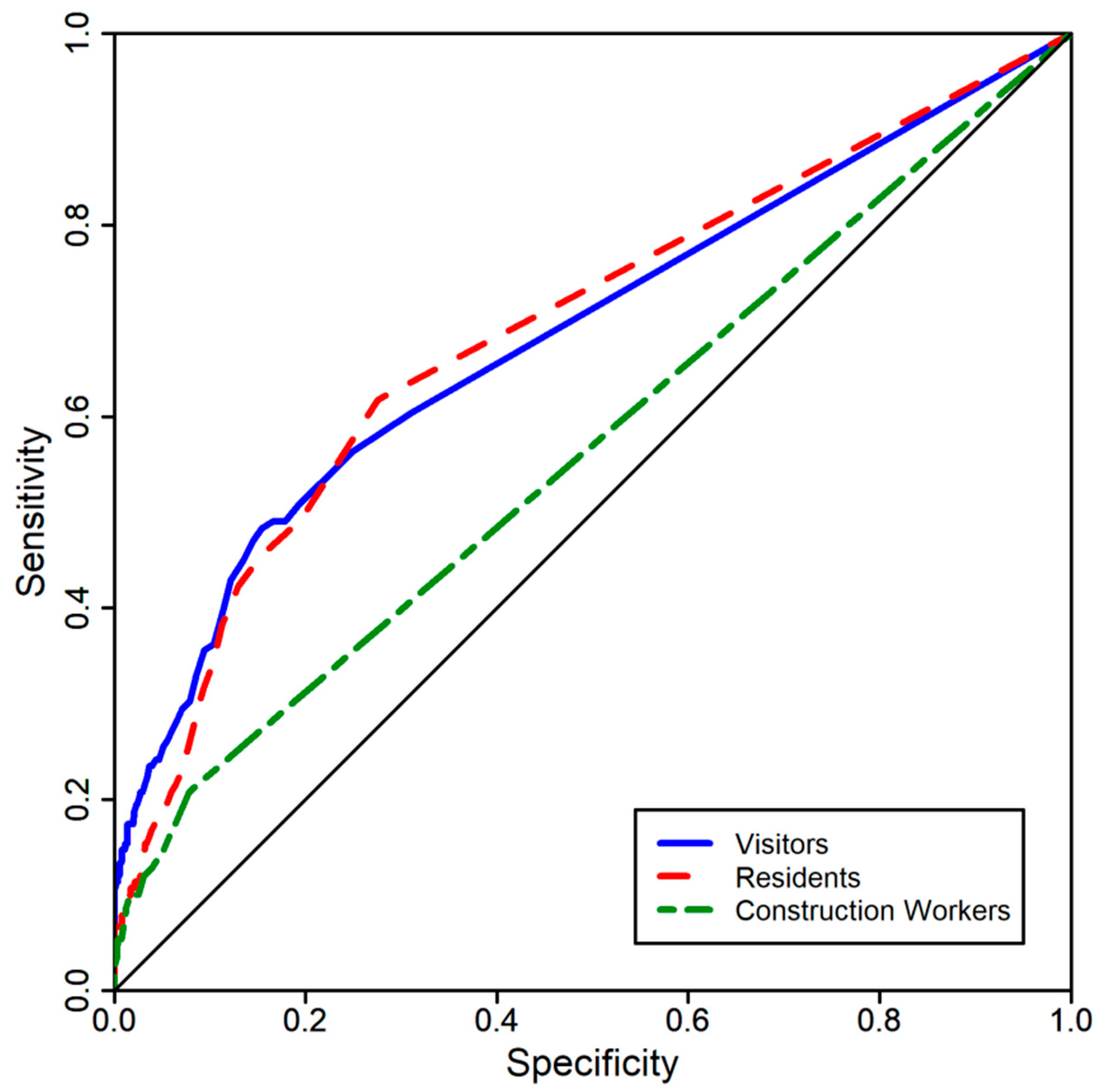
| Construction Workers | Residents | Visitors | |
|---|---|---|---|
| Total number of hexagons with movement into them (%) | 425 (8.2%) | 1478 (28.6%) | 1651 (31.9%) |
| Odds ratio (95% CI) | 3.09 (1.98–4.69) | 4.24 (3.00–6.04) | 3.39 (2.40–4.81) |
| Groups of People | Difference in Area under Curve (AUC) | 95% CI | Standard Error |
|---|---|---|---|
| construction workers and residents | 0.124 (p < 0.05) | 0.069–0.179 | 0.0279 |
| construction workers and visitors | 0.119 (p < 0.05) | 0.062–0.176 | 0.0291 |
| residents and visitors | 0.005 | −0.058–0.068 | 0.0323 |
© 2019 by the authors. Licensee MDPI, Basel, Switzerland. This article is an open access article distributed under the terms and conditions of the Creative Commons Attribution (CC BY) license (http://creativecommons.org/licenses/by/4.0/).
Share and Cite
Rajarethinam, J.; Ong, J.; Lim, S.-H.; Tay, Y.-H.; Bounliphone, W.; Chong, C.-S.; Yap, G.; Ng, L.-C. Using Human Movement Data to Identify Potential Areas of Zika Transmission: Case Study of the Largest Zika Cluster in Singapore. Int. J. Environ. Res. Public Health 2019, 16, 808. https://doi.org/10.3390/ijerph16050808
Rajarethinam J, Ong J, Lim S-H, Tay Y-H, Bounliphone W, Chong C-S, Yap G, Ng L-C. Using Human Movement Data to Identify Potential Areas of Zika Transmission: Case Study of the Largest Zika Cluster in Singapore. International Journal of Environmental Research and Public Health. 2019; 16(5):808. https://doi.org/10.3390/ijerph16050808
Chicago/Turabian StyleRajarethinam, Jayanthi, Janet Ong, Shi-Hui Lim, Yu-Heng Tay, Wacha Bounliphone, Chee-Seng Chong, Grace Yap, and Lee-Ching Ng. 2019. "Using Human Movement Data to Identify Potential Areas of Zika Transmission: Case Study of the Largest Zika Cluster in Singapore" International Journal of Environmental Research and Public Health 16, no. 5: 808. https://doi.org/10.3390/ijerph16050808
APA StyleRajarethinam, J., Ong, J., Lim, S.-H., Tay, Y.-H., Bounliphone, W., Chong, C.-S., Yap, G., & Ng, L.-C. (2019). Using Human Movement Data to Identify Potential Areas of Zika Transmission: Case Study of the Largest Zika Cluster in Singapore. International Journal of Environmental Research and Public Health, 16(5), 808. https://doi.org/10.3390/ijerph16050808




